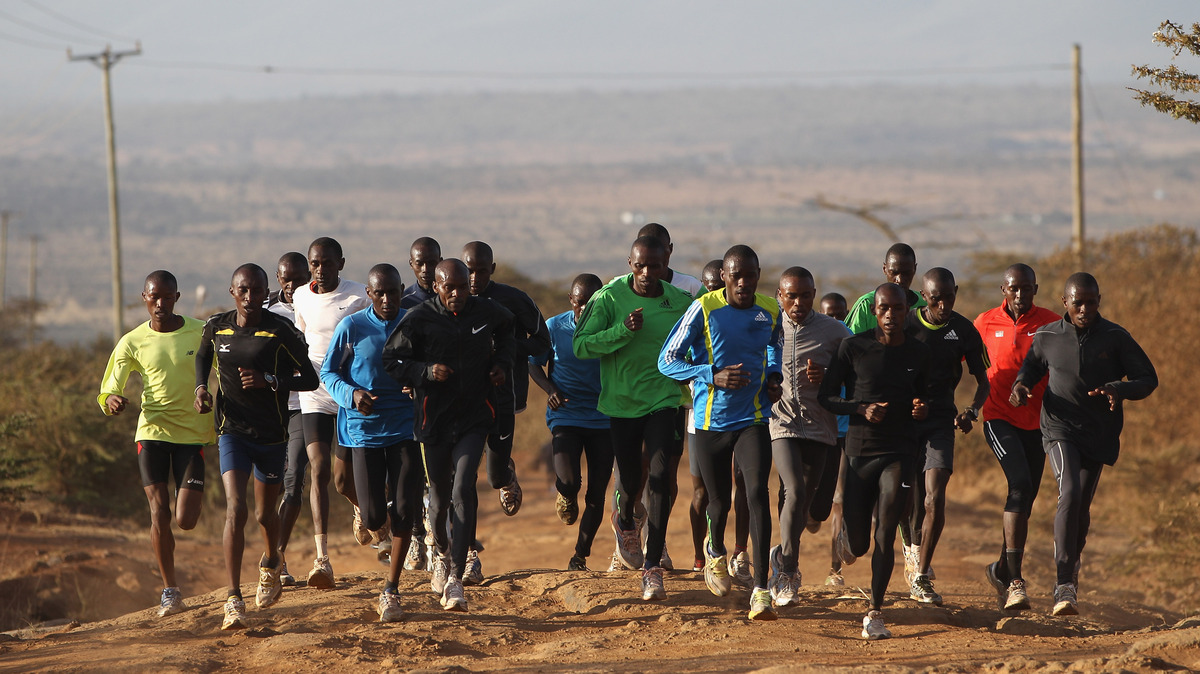Home>Misc>Featured>Long Distance Running Uses Which Muscle Fibers


Featured
Long Distance Running Uses Which Muscle Fibers
Modified: January 2, 2024
Discover the muscle fibers utilized in long distance running. Featured article highlighting the key muscle groups involved in marathon training and endurance running.
Introduction
Long-distance running is a popular form of aerobic exercise that challenges the body both physically and mentally. Whether you’re training for a marathon or simply enjoy the thrill of a long run, understanding the mechanics behind muscle fiber usage can significantly impact your performance and training strategies.
Muscle fibers can be categorized into two main types: slow-twitch (Type I) and fast-twitch (Type II) muscle fibers. These fibers differ in their contraction speed, force production, and endurance capabilities. In long-distance running, both types of muscle fibers play crucial roles in providing the necessary energy and maintaining stamina throughout the run.
In this article, we will delve into the different types of muscle fibers and their specific roles in long-distance running. We will explore the benefits of utilizing both slow-twitch and fast-twitch muscle fibers and discuss training strategies to optimize your muscle fiber usage. By understanding the science behind muscle fibers and implementing effective training techniques, you can enhance your long-distance running performance and achieve your goals.
Types of Muscle Fibers
To understand how muscle fibers are utilized in long-distance running, let’s first examine the two main types of muscle fibers: slow-twitch (Type I) and fast-twitch (Type II) muscle fibers.
Slow-twitch muscle fibers, also known as Type I muscle fibers, are characterized by their endurance capabilities. These fibers contract slowly but can sustain contractions for a longer period of time. They are highly efficient at utilizing oxygen and are rich in mitochondria, which produce energy aerobically. Slow-twitch muscle fibers are responsible for maintaining a steady pace and providing the necessary endurance during long-distance runs. They are essential for lengthy bouts of aerobic activity, as they can continuously generate energy without fatiguing quickly.
On the other hand, fast-twitch muscle fibers, also known as Type II muscle fibers, are responsible for generating quick and powerful contractions. These fibers can be further divided into two subcategories: Type IIa and Type IIb. Type IIa muscle fibers have moderate endurance capabilities and can generate more force compared to slow-twitch fibers. They primarily use both aerobic and anaerobic energy systems. Type IIb muscle fibers, on the other hand, have very high force production but low endurance. They depend primarily on the anaerobic energy system and fatigue quickly.
During long-distance running, both slow-twitch and fast-twitch muscle fibers are engaged, but their contribution varies depending on intensity and duration. Initially, slow-twitch muscle fibers are primarily utilized to set the pace and provide the necessary endurance. As the intensity increases, fast-twitch muscle fibers, especially Type IIa, come into play to generate more force and sustain the effort. However, it is important to note that even during high-intensity runs, slow-twitch muscle fibers still play a significant role in providing endurance and preventing early fatigue.
Understanding the different types of muscle fibers and their characteristics is essential for optimizing training strategies and improving performance in long-distance running. By training both types of muscle fibers, runners can develop a well-rounded and efficient musculature that can endure the demands of long-distance running. In the next section, we will explore the specific roles of these muscle fibers in long-distance running and the benefits of utilizing both types.
Slow Twitch (Type I) Muscle Fibers
Slow-twitch muscle fibers, also known as Type I muscle fibers, are essential for long-distance running. These fibers are characterized by their ability to contract slowly but sustain contractions for a longer period of time. They are highly efficient at utilizing oxygen and are rich in mitochondria, which produce energy aerobically.
When it comes to long-distance running, slow-twitch muscle fibers are responsible for maintaining a steady pace and providing the necessary endurance. These fibers are fatigue-resistant and can generate energy continuously without tiring quickly. They are particularly adept at utilizing fat as a fuel source, making them crucial for prolonged aerobic exercise. As a result, slow-twitch muscle fibers play a significant role in preventing early fatigue during long-distance runs.
Furthermore, slow-twitch muscle fibers are primarily involved in the aerobic energy system. They rely on the steady supply of oxygen to produce energy efficiently. Compared to fast-twitch muscle fibers, slow-twitch fibers have a higher density of blood vessels, allowing for a more efficient delivery of oxygen to the working muscles. This oxygen-rich environment enables slow-twitch fibers to sustain contractions for extended periods and maintain a steady pace throughout the run.
Training slow-twitch muscle fibers is crucial for long-distance runners. Endurance-based exercises like steady-state runs, long runs, and tempo runs are effective in targeting and developing these muscle fibers. Additionally, incorporating strength training exercises with lighter weights and higher repetitions can also stimulate slow-twitch muscle fiber growth.
By training and optimizing slow-twitch muscle fibers, long-distance runners can improve their endurance, delay fatigue, and maintain a consistent pace over extended distances. These muscle fibers are an integral part of successful long-distance running and should be a priority in training programs.
Fast Twitch (Type II) Muscle Fibers
Fast-twitch muscle fibers, also known as Type II muscle fibers, play a crucial role in long-distance running, particularly during high-intensity efforts and sprints. These fibers have the ability to contract quickly and generate high levels of force.
Type II muscle fibers can be further divided into two subcategories: Type IIa and Type IIb. Type IIa fibers have moderate endurance capabilities and can generate more force compared to slow-twitch fibers. They rely on both aerobic and anaerobic energy systems to produce energy. Type IIb fibers, on the other hand, have high force production but low endurance. They primarily depend on the anaerobic energy system and fatigue quickly.
During long-distance running, fast-twitch muscle fibers, particularly Type IIa fibers, come into play during high-intensity efforts, such as uphill sections or bursts of speed. These fibers contribute to generating more force and sustaining the intensity of the run. While slow-twitch muscle fibers are responsible for endurance and maintaining a steady pace, fast-twitch fibers provide the additional power needed for explosive movements and short bursts of speed.
Training fast-twitch muscle fibers is essential for long-distance runners who want to improve their speed and overall performance. Incorporating interval training, hill repeats, and tempo runs can help stimulate and develop these muscle fibers. These types of workouts involve short bursts of high-intensity effort, which engage the fast-twitch fibers and improve their strength and endurance capabilities.
By training and optimizing fast-twitch muscle fibers, long-distance runners can enhance their ability to generate speed, maintain pace during challenging sections, and improve overall performance. These muscle fibers contribute to the well-rounded development of a runner’s musculature and are vital for achieving success in long-distance running.
Long Distance Running and Muscle Fiber Usage
Long-distance running is a demanding endurance activity that requires the utilization of both slow-twitch and fast-twitch muscle fibers. The specific usage of these muscle fibers depends on the intensity and duration of the run.
During the early stages of a long-distance run, slow-twitch muscle fibers are predominantly used. These fibers are responsible for maintaining a steady pace and providing the necessary endurance. They have high resistance to fatigue and can sustain contractions for extended periods without tiring quickly. Slow-twitch muscle fibers primarily rely on aerobic energy production and are adept at utilizing fat as a fuel source. They are crucial for keeping a consistent pace and preventing early exhaustion during long-distance running.
As the intensity of the run increases, fast-twitch muscle fibers come into play, particularly Type IIa fibers. These fibers are responsible for generating force and sustaining the effort during high-intensity bursts or challenging sections of the run. While slow-twitch muscle fibers contribute to the overall endurance, fast-twitch fibers enhance power and speed capabilities. They rely on both aerobic and anaerobic energy systems and provide the necessary strength to maintain performance during intense running segments.
It is important to note that even during high-intensity or sprint efforts, slow-twitch muscle fibers still play a significant role in providing endurance and preventing premature fatigue. They work synergistically with the fast-twitch fibers to maintain a balance between power and endurance throughout the run.
The usage of both slow-twitch and fast-twitch muscle fibers during long-distance running is a dynamic process. The distribution of muscle fiber utilization shifts depending on factors such as pace, terrain, and individual fitness level. Therefore, it is crucial for long-distance runners to train and condition both types of muscle fibers to optimize their performance.
By incorporating a variety of training modalities, such as endurance runs, interval training, hill repeats, and tempo runs, runners can target and develop both slow-twitch and fast-twitch muscle fibers. This comprehensive approach ensures that the musculature is well-rounded, capable of enduring long distances, and possesses the power and speed necessary for optimal performance.
Benefits of Using Different Muscle Fibers in Long Distance Running
The utilization of different muscle fibers, including slow-twitch and fast-twitch fibers, in long-distance running offers several benefits that contribute to overall performance and success. Understanding these benefits can help runners optimize their training strategies and improve their long-distance running abilities.
1. Endurance: Slow-twitch muscle fibers are highly fatigue-resistant and can sustain contractions for extended periods. By incorporating slow-twitch muscle fibers in long-distance running, runners can enhance their endurance and maintain a steady pace throughout the run. These fibers are efficient at utilizing fat as a fuel source, which is beneficial for prolonged aerobic exercise.
2. Explosive Power: Fast-twitch muscle fibers, particularly Type IIa fibers, contribute to generating force and facilitating explosive movements during high-intensity efforts or challenging sections of the run. By training and utilizing fast-twitch fibers, long-distance runners can improve their ability to generate speed, tackle uphill climbs, and execute quick bursts of acceleration.
3. Pace Variation: The utilization of both slow-twitch and fast-twitch muscle fibers allows for the ability to vary pace during a long-distance run. Slow-twitch fibers provide the endurance to maintain a steady pace, while fast-twitch fibers enable runners to increase speed when necessary, such as during sprints or when overtaking competitors. The ability to adjust pace strategically can help runners conserve energy and optimize performance.
4. Injury Prevention: Training and developing both slow-twitch and fast-twitch muscle fibers can help reduce the risk of injury in long-distance running. Slow-twitch fibers provide stability and support for the joints, while fast-twitch fibers contribute to the strength and power necessary for efficient movement. A well-rounded musculature that incorporates both types of muscle fibers can help decrease the likelihood of imbalances and overuse injuries.
5. Overall Performance Improvement: By optimizing the usage of different muscle fibers, long-distance runners can improve their overall performance. The combination of endurance from slow-twitch muscle fibers and power from fast-twitch muscle fibers creates a well-rounded athleticism that allows runners to tackle various terrains and maintain performance over long distances.
Incorporating training strategies that target both slow-twitch and fast-twitch muscle fibers, such as endurance runs, intervals, and strength training, can maximize the benefits of using different muscle fibers in long-distance running. By capitalizing on the unique advantages of each muscle fiber type, runners can enhance their endurance, power, and overall performance, ultimately achieving their long-distance running goals.
Training Strategies to Optimize Muscle Fiber Usage in Long Distance Running
Optimizing muscle fiber usage in long-distance running requires a strategic and well-rounded training approach. By incorporating specific training strategies, runners can target and develop both slow-twitch and fast-twitch muscle fibers, improving their overall performance. Here are some effective training strategies to optimize muscle fiber usage:
1. Endurance Runs: Long-distance runners should include regular endurance runs in their training routine. These runs are performed at a sustainable pace, primarily targeting slow-twitch muscle fibers. Endurance runs not only enhance aerobic capacity but also improve the efficiency of slow-twitch fibers in utilizing oxygen and utilizing fat as a fuel source.
2. Interval Training: Interval training involves alternating between periods of high-intensity effort and recovery. This type of training stimulates both slow-twitch and fast-twitch muscle fibers. By incorporating intervals into the training program, runners can improve their speed, power, and overall muscle fiber recruitment.
3. Hill Repeats: Running uphill places a greater demand on the muscles, particularly fast-twitch fibers. Including hill repeats in the training regimen can help develop power and strength in these muscle fibers. Uphill running also improves running economy, which is crucial for maintaining pace during challenging sections of a race.
4. Tempo Runs: Tempo runs involve maintaining a challenging but sustainable pace for an extended period. These runs target both slow-twitch and fast-twitch muscle fibers, improving endurance and threshold capabilities. Tempo runs help improve lactate threshold, allowing runners to sustain higher speeds for longer periods without excessive fatigue.
5. Strength Training: Incorporating strength training exercises into the training routine can enhance muscle fiber development and overall performance. Focus on exercises that target multiple muscle groups, such as squats, lunges, deadlifts, and plyometric exercises. Strength training helps develop power, improves muscle coordination, and reduces the risk of injury.
6. Cross-training: Engaging in cross-training activities, such as cycling, swimming, or rowing, can help vary the stress placed on the muscles and recruit different muscle fibers. This helps prevent overuse injuries while maintaining overall fitness and conditioning.
By combining these training strategies and tailoring them to individual needs and goals, runners can optimize muscle fiber usage in long-distance running. It is important to gradually increase the intensity and duration of training sessions, allowing the muscles to adapt and develop over time. Consistency, proper nutrition, and adequate rest and recovery are also crucial factors in optimizing muscle fiber usage and achieving peak performance in long-distance running.
Conclusion
Understanding the role of different muscle fibers in long-distance running is essential for optimizing performance and achieving success. Slow-twitch (Type I) muscle fibers provide the endurance and stamina necessary for maintaining a steady pace throughout the run, while fast-twitch (Type II) muscle fibers contribute to explosive power and speed during high-intensity efforts. Both types of muscle fibers play a vital role in long-distance running, and training strategies should aim to develop and optimize the usage of both fiber types.
By incorporating specific training techniques such as endurance runs, interval training, hill repeats, tempo runs, and strength training, runners can target and develop the various muscle fibers needed for long-distance running. These strategies enhance endurance, power, speed, and overall performance, ensuring a well-rounded musculature that can handle the demands of a long-distance run.
Optimizing muscle fiber usage not only improves performance but also helps prevent injuries by maintaining balance and reducing the risk of overuse. Developing both slow-twitch and fast-twitch muscle fibers improves running economy, increases lactate threshold, and enhances the ability to maintain pace during challenging sections of a run.
Remember that each runner is unique, and training strategies should be tailored to individual needs and goals. Consistency, proper nutrition, and adequate rest are crucial components of long-distance running training. Patience and perseverance are key, as developing muscle fibers and optimizing their usage takes time and commitment.
By understanding the science behind muscle fiber usage and implementing effective training strategies, long-distance runners can enhance their performance, achieve their goals, and experience the thrill and fulfillment of conquering long distances with strength and endurance. So lace up those shoes, hit the road, and unleash the full potential of your muscle fibers in the exciting journey of long-distance running.









